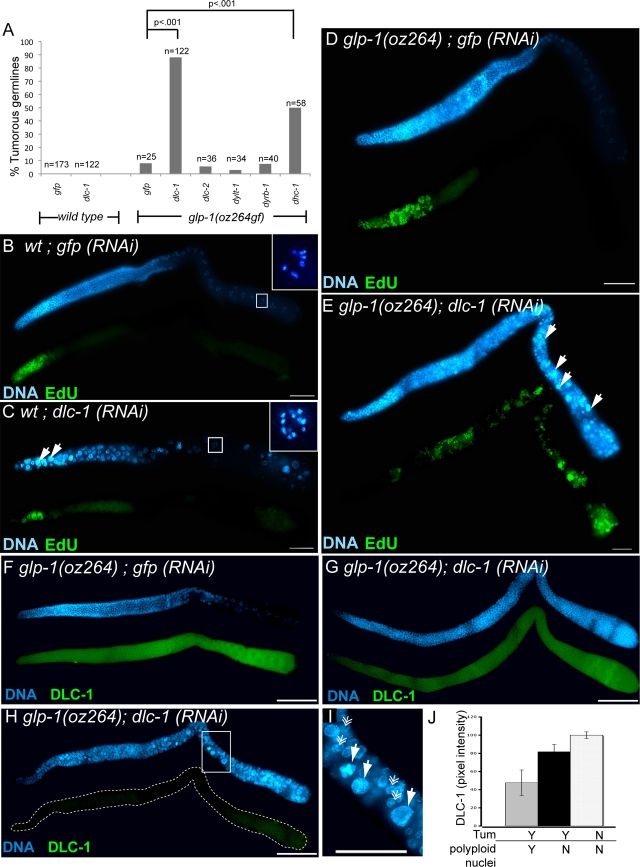FIG. 2.
dlc-1 functions to inhibit proliferative fate in the C. elegans germ line. (A) RNAi against dlc-1 and dhc-1 enhances tumor formation in the glp-1(oz264gf) background at 20°C, while RNAi against other light chains does not. dlc-2, paralog of dlc-1; dylt-1, Tctex-type dynein light chain; dyrb-1, Roadblock-type light chain. Two-tailed P values were determined using Fisher's exact test. (B, C) In wild-type germ lines (B), as well as in dlc-1 RNAi of control animals (C), a 3-h pulse of the nucleotide analog EdU, which incorporates during DNA synthesis, labels (green) only the very distal end (left) of the germ line, although dlc-1 RNAi causes abnormal nuclei containing large, dense DNA bodies (white arrows) and unpaired chromosomes in diakinesis to occur. Insets show chromosomal morphology of diakinetic oocytes, with six sets of bivalents in oocytes from control germ lines (B) but 12 univalents for dlc-1 RNAi (C). (D, E) dlc-1 RNAi causes tumor formation and EdU incorporation throughout the germ line in glp-1(oz264gf) (E), while the glp-1(oz264gf) mutant on its own has only a marginal increase in EdU incorporation (D). (F to H) Staining against DLC-1 (green) in glp-1(oz264gf) animals treated with double-stranded RNA targeting either gfp as a control (F) or dlc-1 (G, H). (G) A tumorous germ line with partial DLC-1 knockdown and unaffected nuclear morphology; (H) a tumorous germ line with stronger DLC-1 knockdown and abnormal nuclear morphology. (I) This inset from panel H highlights the large size of abnormal nuclei. Solid arrows indicate large, DNA-dense (abnormal) nuclei, and feather arrows indicate nuclei of relatively normal size. (J) Quantification of DLC-1 levels by pixel intensity for glp-1(oz264gf); gfp(RNAi) germ lines (white bar), glp-1(oz264gf); dlc-1(RNAi) tumorous germ lines with normal nuclear morphology (black bar), and glp-1(oz264gf); dlc-1(RNAi) tumorous germ lines with abnormal nuclear morphology (gray bar). Error bars indicate the standard errors of the means for the results. All scale bars = 20 μm. Tum, tumorous; wt, wild type.

